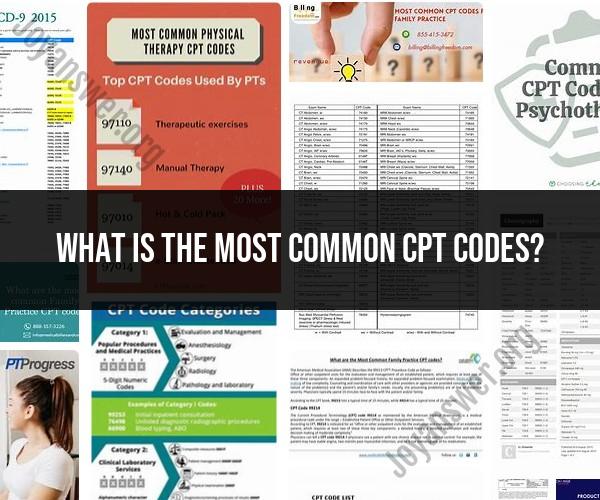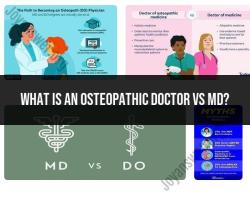What is the most common CPT codes?
The most common Current Procedural Terminology (CPT) codes in the field of medical procedure coding can vary depending on several factors, including the medical specialty, geographic region, and changes in healthcare practices. However, I can provide you with some commonly used CPT codes across various medical specialties. Keep in mind that these rankings may have changed since then, so it's a good idea to consult the most recent data or coding resources for up-to-date information. Here are some historically common CPT codes:
Office or Outpatient Evaluation and Management (E/M) Services:
- 99213 - Established patient office visit, level 3
- 99214 - Established patient office visit, level 4
- 99203 - New patient office visit, level 3
- 99204 - New patient office visit, level 4
Preventive Medicine Services:
- 99381 - Initial comprehensive preventive medicine evaluation, infant
- 99391 - Periodic comprehensive preventive medicine reevaluation, adolescent
- 99397 - Periodic comprehensive preventive medicine reevaluation, adult
Diagnostic Tests and Procedures:
- 85025 - Complete blood count (CBC) with automated differential
- 80053 - Comprehensive metabolic panel
- 81002 - Urinalysis, manual test
Radiology Services:
- 71010 - Chest X-ray, single view
- 72100 - X-ray of the lower back (lumbar spine), two views
- 77057 - Screening mammography, bilateral (2-view study of each breast)
Surgical Procedures:
- 29881 - Arthroscopy, knee, surgical; with meniscectomy (medial OR lateral)
- 43239 - Upper gastrointestinal endoscopy, biopsy
- 45378 - Colonoscopy, diagnostic, including collection of specimen(s) by brushing or washing
Anesthesia Services:
- 00170 - Anesthesia for procedures on the eye, lens surgery
- 00300 - Anesthesia for endoscopic procedures on the upper gastrointestinal tract
Emergency Department Services:
- 99282 - Emergency department visit, moderate severity, level 2
- 99283 - Emergency department visit, moderate severity, level 3
- 99284 - Emergency department visit, moderate severity, level 4
Pathology and Laboratory Services:
- 84443 - Thyroid stimulating hormone (TSH)
- 85027 - Complete blood count (CBC), automated
- 85610 - Prothrombin time (PT)
Healthcare professionals, including medical coders, regularly update their knowledge to stay current with the latest coding guidelines and changes.
Commonly Used CPT Codes: A Look at the Most Frequent Medical Procedures
CPT codes, or Current Procedural Terminology codes, are used to describe medical procedures and services. They are used by healthcare providers, insurance companies, and government agencies to bill for services and track healthcare utilization.
The most commonly used CPT codes are typically for routine office visits and procedures. Some of the most common CPT codes include:
- 99214: Established patient office or other outpatient visit for the evaluation and management of an established patient, which requires a medically appropriate history and/or examination and moderate decision making.
- 99215: Established patient office or other outpatient visit for the evaluation and management of an established patient, which requires a medically appropriate history and/or examination and high decision making.
- 99217: Established patient office or other outpatient visit for the evaluation and management of an established patient, which requires a medically appropriate history and/or examination and complex decision making.
- 82947: Complete blood count with differential.
- 82948: Comprehensive metabolic panel.
- 82949: Urinalysis.
- 82950: Lipid panel.
- 82951: Thyroid stimulating hormone (TSH).
- 82952: Vitamin D.
- 82953: A1C.
- 82954: Complete blood count with differential and platelets.
- 82955: Comprehensive metabolic panel with lipids.
- 82956: Comprehensive metabolic panel with lipids and A1C.
- 82957: Urinalysis with microscopy.
- 82958: Urinalysis with microscopy and culture.
- 82959: Urinalysis with microscopy, culture, and sensitivity.
Navigating Medical Billing: Understanding the Prevalent CPT Codes
Medical billing can be a complex process, but understanding the most prevalent CPT codes can help you navigate it more effectively.
When you receive a medical bill, it will list the CPT codes for the services that were provided. You can then use these codes to look up the descriptions of the services and to verify that they were medically necessary. You can also use the CPT codes to compare the charges billed by your healthcare provider to the rates that are typically charged for those services in your area.
If you have any questions about your medical bill, or if you believe that there may be an error, you should contact your healthcare provider or insurance company.
The Backbone of Medical Coding: The Most Commonly Utilized CPT Codes
The most commonly utilized CPT codes are the backbone of medical coding. They are used to bill for the most common and routine medical services.
By understanding the most commonly used CPT codes, healthcare providers can ensure that their coding is accurate and compliant. Insurance companies can also use this information to process claims more efficiently.
The most commonly utilized CPT codes are also used by government agencies to track healthcare utilization and to develop healthcare policies.
By understanding the most commonly used CPT codes, you can have a better understanding of the medical services that are provided and the costs associated with those services.












